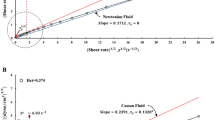Abstract
The influence of the change in the temperature and the acidity of blood on its hemorheological properties has been analyzed. It is shown that, at temperatures lower than 45°C, the temperature dependence of the apparent viscosity of blood at a rate of shear ranging from 0.3 to 50 sec−1 is adequately defined by the Arrhenius model with a viscous-flow activation energy of 13–17 kJ/mole. In the range of pH 6.3–7.6, the oversouring of blood mainly influences the critical shear stress, and the Caisson viscosity depends only weakly on the acid-base equilibrium.
Similar content being viewed by others
References
H. A. Platt, J. V. Chuba, and H. S. Kaplan, Initial studies of the temperature-viscosity relationship of human plasma and serum, Biorheology, 15, 29–35 (1978).
V. A. Levtov, S. A. Regirer, and N. Kh. Shadrina, Rheology of Blood [in Russian], Meditsina, Moscow (1982).
H. Chmiel, New experimental results in hemorheology, Biorheology, 11, 87–96 (1974).
W. H. Newman, P. P. Lele, and H. F. Bowman, Limitations and significance of thermal washout data obtained during microwave and ultrasound hyperthermia, Int. J. Hyperthermia, 6, No. 4, 771–784 (1990).
E. W. Merrill, Rheology of blood, Physiol. Rev., 49, 863–887 (1969).
V. A. Mansurov, V. V. Kulebyakin, and Z. P. Shul’man, Special features of the temperature dependence of the rheological properties of blood at low rates of shear, Vestsi Nats. Akad. Navuk Belarusi, Ser. Biyal. Navuk, No. 3, 114–116 (1996).
V. A. Mansurov, V. V. Kulebyakin, and S. V. Vilanskaya, About temperature dependence of the rheological properties of human blood at low rates of shear, Inzh.-Fiz. Zh., 69, No. 3, 386–389 (1996).
S. Y. Lee, Ch. W. Song, and S. Levitt, Change in fibrinogen uptake in tumors by hyperthermia, Eur. J. Cancer Clin. Oncol., 21, 1507–1513 (1985).
P. G. Reitnauer and M. von Ardenne, Zu einem hämorheologischen Aspekt bei der Kombination von Tumorübersäuerung und Hyperthermie, Deutsche Zeitschift für Onkologie, 23 (1991).
Author information
Authors and Affiliations
Additional information
__________
Translated from Inzhenerno-Fizicheskii Zhurnal, Vol. 78, No. 5, pp. 180–185, September–October, 2005.
Rights and permissions
About this article
Cite this article
Shul’man, Z.P., Makhanek, A.A. Influence of the temperature and oversouring of blood on its hemorheological properties. J Eng Phys Thermophys 78, 1022–1028 (2005). https://doi.org/10.1007/s10891-006-0030-4
Received:
Issue Date:
DOI: https://doi.org/10.1007/s10891-006-0030-4



